Archive for June 2012
Halfway to Failure
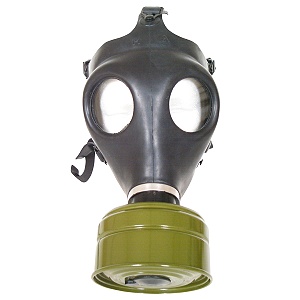 (Late Monday evening update: It's clear that the Hinton Street monitor will record its third "exceedence" of the 85 ppb standard this year, putting it just one away from making the entire region non-attainment" in 2012.)
(Late Monday evening update: It's clear that the Hinton Street monitor will record its third "exceedence" of the 85 ppb standard this year, putting it just one away from making the entire region non-attainment" in 2012.)
It's a bad sign when there are ozone problems on the weekends. It means that even with less people on the road and many businesses on less than full throttle, there's still enough pollution to cause trouble. And it usually means a rough week ahead. That's what happened on Sunday, when summer finally caught up with DFW in a big way.
Four area ozone monitors set new annual highs set on Sunday, and many others saw very alarming numbers during the afternoon. There were three "exceedences" of the old 1997 85 parts per billion ozone standard, and one of those was the second time the Dallas Hinton Street site had seen an 8-hour average above 85 this year. Six other monitors have already had their first. And it's only June.
Four such exceedences within a year puts a monitor in official violation of the obsolete standard that DFW is still struggling to meet. So with the Hinton Street results, we're already halfway to being out of compliance with the 1997 standard again. But it's all academic. Everything is now geared toward meeting the new 75 parts per billion ozone standard by 2018. DFW could be in violation of the old standard every year from now until then, and except for the terrible toll on public health, there'd be no penalty from either the EPA or TCEQ.
On the other hand, its going to be pretty hard to meet that new, harder standard when you haven't been meeting the old, easier one.
The state's official response is mostly to sit back and hope that DFW drivers trade in their older, more polluting cars for cleaner, newer ones. That phenomena was supposed to be responsible for making this year the best one for clean air in decades. According to the Texas Commission on Environmental Quality's computer modeling, no DFW monitor will violate the Clean Air Act for ozone pollution in 2012. At least, that's what they told the EPA when they submitted the region's clean air plan to the feds in December. And the EPA bought it. Because the TCEQ computer modeling said everything was hunky-dory.
But reality has a way of rudely intruding on TCEQ's computer modeling. Only six months into the new plan and most of the DFW monitor averages predicted by the state are already underestimates. We had the highest ozone levels ever recorded in March. Maybe there's just not enough of you trading in your cars.
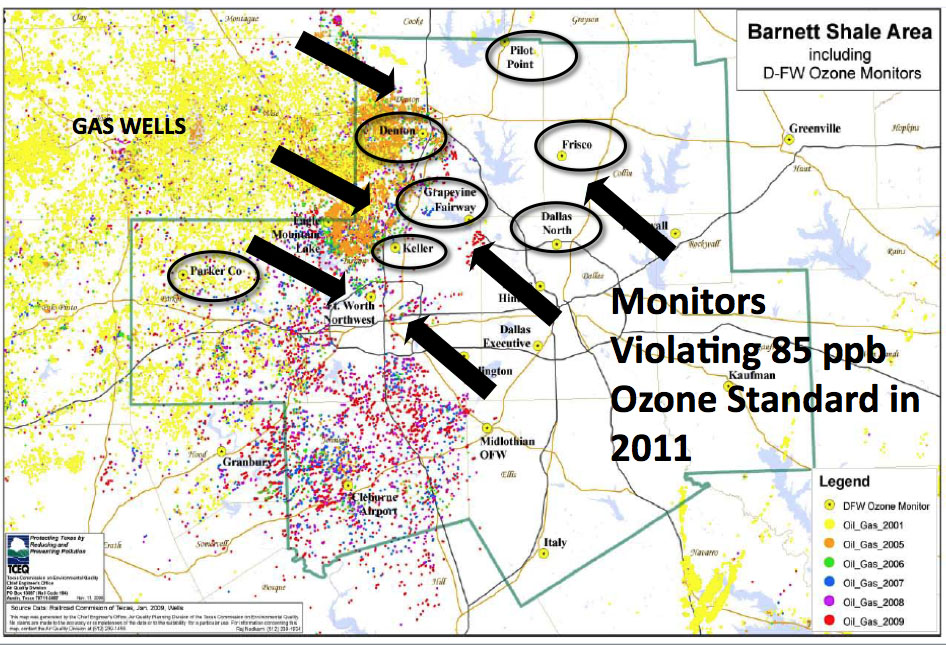 Or maybe it's just that old TCEQ junk science at work. One thing we know the state's computer model didn't consider was how already-dirty air makes the VOC pollution from natural gas operations more easily convert into ozone pollution. Denver officials who are also dealing with new gas operations contributing to long-standing smog problems have considered this factor and think it explains larger than expected ozone readings there.
Or maybe it's just that old TCEQ junk science at work. One thing we know the state's computer model didn't consider was how already-dirty air makes the VOC pollution from natural gas operations more easily convert into ozone pollution. Denver officials who are also dealing with new gas operations contributing to long-standing smog problems have considered this factor and think it explains larger than expected ozone readings there.
TCEQ chose to ignore this variable. Supposedly because the gas patch was well west of DFW and "couldn't possibly" affect North Texas ozone levels. But as anyone who's driven I-30 or I-20 over the past ten years can tell you, the gas patch extends all the way from east of Denton to Grand Prairie to Midlothian, encompassing most of the 9 county non-attainment area. In the same December 2011 clean air plan the state predicted record-low ozone levels this year, it also estimated that gas industry sources were emitting 34 tons per day more smog-forming VOC pollution than all the cars and trucks in DFW combined.
It was a political decision not to look at how dirty air from Houston, the East Texas coal plants, the Midlothian cement kilns and everything else east of Weatherford makes gas industry emissions more likely to cause ozone in North Texas. TCEQ's clean air plans are always full of such decisions that drive the final results of its supposedly objective computer modeling. Hard to believe now, but there was a time in the not-so-distant-past that the same computer modeling made it clear that the Midlothian cement plans "couldn't possibly" be affecting DFW ozone levels.
A plan to meet the new 75 ppb standard must be submitted to EPA by 2015 to show three years of compliance by 2018. That's only two-years away. If new cars alone can't get us down below 85, it will be extremely difficult for the state to argue they can get us down to 75. More actual things that work to reduce pollution will be necessary. Including bringing better controls to the cement kilns and coal plants and other industries still putting out way too much pollution. It will be a fight. but so far, the evidence is that more is needed if DFW is ever going to have safe and legal air.
Fracking Call to Action
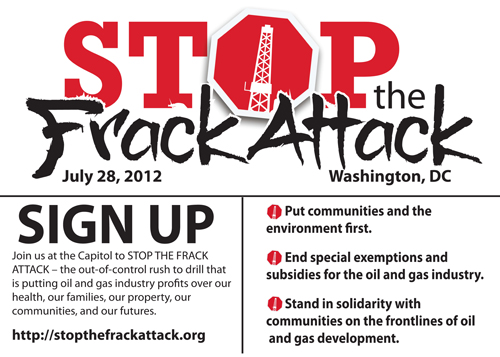 There are a bunch of grassroots groups endorsing and planning a late July series of actions in Washington DC aimed at countering the surge of fracking going on nationwide. The decentralized nature of the thing reflects the origins of the movement itself – one born inside the gas fields, not the Beltway. This is a good thing. The downside is that none of these groups have the kinds of budgets that allow them to go out and book fleets of buses or floors of hotels on spec. Nevertheless, they're trying to make it easy and cheap for you to do-it-yourself online with advice and listing and a checklist for booking buses and connecting you with housing opportunities in DC. You don't have to be a college kid with a sleeping bag. You can be a middle-aged couple with kids. They'll find spaces with real beds. Here's the FAQ page that can get you started.
There are a bunch of grassroots groups endorsing and planning a late July series of actions in Washington DC aimed at countering the surge of fracking going on nationwide. The decentralized nature of the thing reflects the origins of the movement itself – one born inside the gas fields, not the Beltway. This is a good thing. The downside is that none of these groups have the kinds of budgets that allow them to go out and book fleets of buses or floors of hotels on spec. Nevertheless, they're trying to make it easy and cheap for you to do-it-yourself online with advice and listing and a checklist for booking buses and connecting you with housing opportunities in DC. You don't have to be a college kid with a sleeping bag. You can be a middle-aged couple with kids. They'll find spaces with real beds. Here's the FAQ page that can get you started.
The event is more than a rally. Its a four-day extravaganza in which you'll be able to meet your peers from all over the country and receive new ideas and information you can bring home to use in your own fight. Although it's not a Carribbean cruise, you'll more than get your money's worth. Here's the schedule
Wednesday- July 25th
Trainings
6:30pm-8:00pm Evening Lobbying and Marshall Trainings
Location: TBA
These trainings are not required for people who are lobbying, but we highly recommend that you attend. We will discuss how to lobby, what our asks to members are, what to expect from lobbying meetings and more importantly how to get around the Hill! We will also be having a Marshall Training where we will go over conflict resolution and the plan for the march and fracking water drop-off. We’ll also give out some other roles that we need filled to make sure STFA goes off without a hitch.
Thursday- July 26th
Lobby Day
9:00am-5:00pm Lobbying at the US Capitol
Location: US Capitol Visitor Center (we will have a space there all day)
After being trained the night before, we will hit the pavement of Capitol Hill and bring our message to our members of Congress. Lobbying is a tactic that is as old as government itself, and is a great way to create the pressure needed to close the loopholes in the Clean Water and Clean Air Acts. We will also take a group photo at noon on the steps of the Capitol!
More questions? Concerns? Shoot us an email: info@stopthefrackattack.org
Friday- July 27th
Stop the Frack Attack Gathering
10:00am- Noon: Trainings
Location: St. Stephens Church, 1525 Newton St. NW Washington, DC 20006
You’ve told us you want training before our day of action. Please fill out this survey to help us decide the topic of our fourth training! Check out the survey here!
1:00pm- 5:00pm: Strategy Session
Fracktivists from far and wide are coming to DC, and it’s time to figure out how we are actually going to win. We will break up by geographic regions, with a separate youth group, and talk strategy. What’s working? What’s not? What can we do better? These are the questions we hope to answer.
6:30-8:30: Town hall
We are working hard to get this event off the ground and we are gaining some traction, consider this the pre-rally. Our goal is to get someone from the Obama Administration here to talk to us about fracking and then have an open Q&A session… word on the street is it might be someone big, we’ll keep you posted!
Saturday- July 28th
Rally and March
2:00pm Rally
Location: The West Lawn of the Capitol
This is the big day, we are organizing to get as many people as possible! We have people coming from Texas, West Virginia, New York, Vermont, and even Australia. If you want to help get people there you can organize a bus! This rally will give us the energy needed to take our demands to the corporate powers pushing fracking onto our communities.
3:30 pm March
Location: The Streets of DC
After getting pumped up by our awesome speakers, it’s time to hit the streets. We will make a special delivery to the American Petroleum Institute and American Natural Gas Association. They say fracking is good for our water, we say nay and have the water to prove it!
And here's the mission statement for the action:
A rush to drill is sweeping the United States. Across the country, the oil and gas industry is surging into new areas as quickly and cheaply as possible.
And they have been using techniques like hydraulic fracturing (“fracking”) long before we fully understand the extent of the negative impacts on the health of the local people, communities, water, air, climate, and other critical resources.
Landowners and communities are struggling to cope: Existing laws are outdated and loophole-riddled, and enforcement is universally inadequate and underfunded. We battle a persistent myth that gas is a “clean” energy – which is not only false, but keeps us from moving towards truly clean energy and ending our reliance on fossil fuels.
The result: as industry rakes in record profits from fracking-enabled drilling, it passes on drilling’s heaviest costs to landowners, local communities and future generations. That’s because elected leaders (sometimes influenced by dirty energy money) too often refuse to hold the industry accountable for the damage they cause, or require them to prevent it.
The rush to drill, and the tragic consequences that follow, has made fracking a household word. In the process it has made “fracktivists” out of thousands of ordinary citizens — including some who regard “environmentalist” as a dirty word. Some are working to prevent fracking in their communities. Those already affected are fighting to protect their air, water, and health.
We all want to STOP THE FRACK ATTACK – the out-of-control rush to drill that is putting oil and gas industry profits over our health, our families, our property, our communities, and our futures.
Now is the time for us all to unite and demand that decisionmakers inside the Beltway hear our voice and take action to change the way the oil and gas industry operates in this country.
On July 28th, 2012, we invite community members and organizations everywhere to join us in Washington, D.C. for a rally at the Capitol to demand no more drilling that harms public health, water, and air. Instead of pushing for the increased use of oil and gas, elected officials and public agencies must insist that the industry stop all drilling that is dirty and dangerous, and put communities and the environment first, starting by removing special exemptions and subsidies for the oil and gas industry.
Join community leaders, celebrities and policymakers and add your voice to the call for a clean, fossil fuel free energy future.
Won’t you join us?
Signed,
Advisory Council:
Julie Archer, West Virginia
Stephen Cleghorn, Pennsylvania
John Fenton, Wyoming
Robert Finne, Arkansas
Rick Humphreys, West Virginia
Jenny Lisak, Pennsylvania
Kari Matsko, Ohio
Jill Morrison, Wyoming
Calvin Tillman, Texas
Matia Vanderbilt, Maryland
Jill Wiener, New York
Partners in Crime: TCEQ Lets Exide Lead Smelter Air Plan Deadline Pass
 Yeah, it's supposed to close by the end of the year. But that shouldn't mean the Exide lead smelter gets an even larger free pass to keep breaking the law on its way out the door.
Yeah, it's supposed to close by the end of the year. But that shouldn't mean the Exide lead smelter gets an even larger free pass to keep breaking the law on its way out the door.
Under the Clean Air Act, the facility is still subject to a clean-up plan for lead emissions that are violating the new federal lead-in-air standards passed in 2008. It's called a "State Implementation Plan," or SIP, because the state environmental agency, in this case the Texas Commission on Environmental Quality, is supposed to submit it to EPA for approval. The deadline for submitting Exide's SIP is July 1st, so the EPA has the required six months for public comment and processing through the Federal Register by the time the standard takes effect in December. As of today, the agenda for the last TCEQ Commissioners meeting in June did not have the Exide SIP on it.
It's true that the smelter doesn't have to start meeting that new standard until less than a month before it's scheduled closing via the agreement Exide and the City of Frisco announced in late May (and it's been exeeding that standard pretty regulalry since Spring began). But the adoption of a SIP could have put a nice regulatory bow on the package that the company and city have already prepared, and given the state the chance to tie up lots of loose enforcement ends.
By not submitting the SIP to EPA on time, the TCEQ is in violation of the law. What EPA will do about that is unknown, although its advocacy on behalf of Frisco residents over the long history of the smelter has been less than comprehensive and enthusiastic. Even now, neither it nor TCEQ have announced any fines or enforcement measures despite finding plenty of evidence of violations over the last three years' worth of inspections, much less the documented 30-year history of chronic abuses found in the agencies' files.
What might be some of the real world consequences of TCEQ lawbreaking this time? More lead air pollution and lead exposure to Frisco residents in the next six months than would otherwise have been allowed and more contamination of the land the City of Frisco has already bought and must pay to clean-up. A good thing to remember is how the company phased-out its Dixie Metals smelter in Dallas when it was forced to close by a December 31st 1990 deadline by the city. There was full production at the smelter until 12 Midnight, December 31st.
The official apathy of the state and federal agencies regarding Exide's criminal past and present has been breathtaking at times. So far, this missed SIP deadline seems to be one more yawnfest for them. Which is all the more reason citizens have to keep a vigilant eye on things even after the hoopla is over and the important work of cleaning-up a half-century's worth of poisons begins. Environmental protection is a do-it-yourself proposition.
Clean Air As Political Football
 Yesterday's Senate vote on rolling back the new EPA Mercury rules for power plants is a great example of how both sides use fake controversies to puff-up their political bone fides and financial support.
Yesterday's Senate vote on rolling back the new EPA Mercury rules for power plants is a great example of how both sides use fake controversies to puff-up their political bone fides and financial support.
At issue is another move by Senator Inhofe of Oklahoma to gut the widely popular regulations that would establish limits for mercury pollution from power plants – the largest source of the air-borne poison in the US.
Inhofe's motives are pretty clear – this is just one more run at trying to deconstruct the EPA and the last 40 years of government-mandated clean air provisions. This is what the Senator does. Even when he knows he doesn't have the votes to win weeks in advance, as was the case with this vote. Why? Because it's a presidential election year and the EPA is red-meat to the Republican Party core constituency. After a week of publicity about the rules and the chance to demagogue against them, the vote itself is a mere formality. In fact, losing the vote gives the Senator a chance to say that the only way to permanently get rid of these kinds of awful business-killing EPA regulations is to elect a Republican president and Senate. Get those fundraising letters out. Mission accomplished.
Likewise, many of you probably received urgent appeals from large national environmental groups to e-mail your Senators about this power plant vote or risk losing the rules. This too was political posturing. If you'd been keeping track of the debate, you knew Senator Inhofe did not have the votes to win in the Senate. And even if he had somehow won, the President still would have vetoed the bill. The rules themselves were never in any danger. So why send out urgent appeals? Because it's a presidential election year and the Republican threat to EPA is a red meat issue to a core Democratic/Environmental constituency. After a week of scaring people into believing the rules were in jeopardy, the vote itself was a mere formality. And the "closeness" of the vote means that the only way we can protect rules like these is to keep a Democratic president and Senate. Cue those fundraising appeals. Mission accomplished.
Tomorrow, it's very likely that the Obama Administration will begin the self-inflicted process of dismantling parts of the EPA's new emission rules for cement plants that Downwinders and others have worked almost two decades to see implemented. These rules govern Mercury emissions too – cement plants are also a major source. For no reason that anyone in the environmental establishment in DC can understand, the EPA is going out of its way to weaken and delay these rules. This is not a drill. This is actually happening. And it's not the fault of Senator Inhofe this time. It's the Obama EPA. But the Senator won't be crowing about it because it doesn't conform to his own popular narrative about an anti-business EPA. We'll wait and see, but we also imagine there won't be any urgent national calls from Washington environmental groups next week to stop the EPA from eating its own and save the cement plant rules. That's not the narrative they're trying to sell either.
But it's the one taking place on the ground in Midlothian and another two dozen or so communities across the country that were depending on these rules to make their lives less miserable.
Post Facto Public Hearing on Frisco’s Purchase of Exide Property Thursday Night
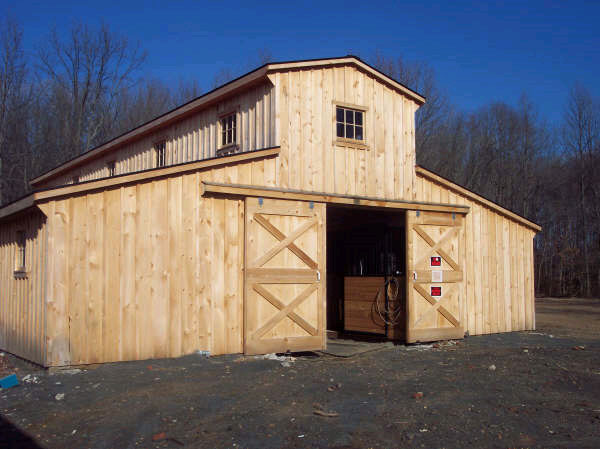 Not sure of what the point is of having a public hearing on a done deal, but that's what the Frisco Community Development Corporation is doing Thursday night at 6:30 at Frisco City Hall, where items 1 and 2 on the agenda are public hearings on the pieces of Exide plant property the CDC is buying as part of the larger buy-out of the smelter announced in early June. It might have been more useful to have such a thing before the city signed off on the agrement so citizens could learn of the extent of soil testing being done, or debate about how low clean-up levels should be for any kind of new economic developmnet on the proprty. But oh well. Still, if you're a Frisco resident, it might be a good thing to offically register your concern at the potential leaden pig in a poke the city owns now and why you want the best, most thorough clean-up possible of all Eide properties.
Not sure of what the point is of having a public hearing on a done deal, but that's what the Frisco Community Development Corporation is doing Thursday night at 6:30 at Frisco City Hall, where items 1 and 2 on the agenda are public hearings on the pieces of Exide plant property the CDC is buying as part of the larger buy-out of the smelter announced in early June. It might have been more useful to have such a thing before the city signed off on the agrement so citizens could learn of the extent of soil testing being done, or debate about how low clean-up levels should be for any kind of new economic developmnet on the proprty. But oh well. Still, if you're a Frisco resident, it might be a good thing to offically register your concern at the potential leaden pig in a poke the city owns now and why you want the best, most thorough clean-up possible of all Eide properties.
Bad Air? There’s an App for That
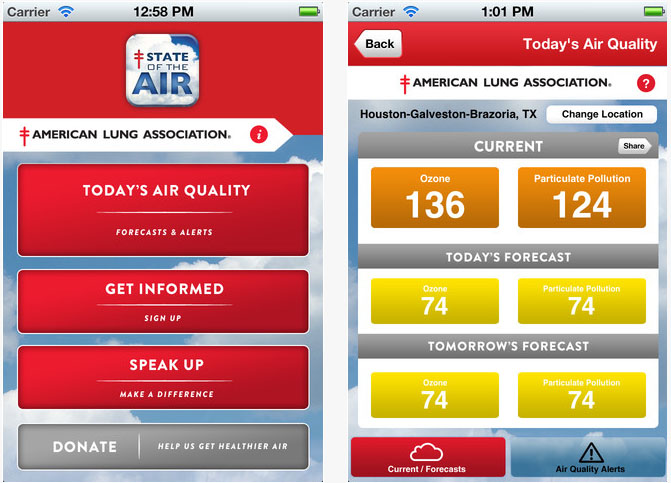 Via the Dallas Morning New comes word that the American Lung Association has developed a new i-phone and Android app that can keep track of your local air quality status. It supposedly brings you real time smog and particulate matter info using the EPA's brightly colored Air Quality Index that you may have seen on local weather cast, although "real time" in this case is about 2 hours behind the actual numbers you'll be breathing thanks to the state's slow posting. It also offers the handy option of sending clean air messages to members of Congress and donating to the ALA. Having a bad air day? Make sure your elected offciials know.
Via the Dallas Morning New comes word that the American Lung Association has developed a new i-phone and Android app that can keep track of your local air quality status. It supposedly brings you real time smog and particulate matter info using the EPA's brightly colored Air Quality Index that you may have seen on local weather cast, although "real time" in this case is about 2 hours behind the actual numbers you'll be breathing thanks to the state's slow posting. It also offers the handy option of sending clean air messages to members of Congress and donating to the ALA. Having a bad air day? Make sure your elected offciials know.
Methane Just Tastes Better Than Those Other Brands of Fossil Fuel
Fracking, and Levees, and Dams, Oh My! Army Corps of Engineers Meets With Dallas City Hall
 Dallas City Hall staff met with representatives of the Army Corps of Engineers last week to get a briefing on the Corps' enforcement of its recommended 3000 foot "protective zone" between natural gas drilling sites and any dams, levees, and other water retention structures.
Dallas City Hall staff met with representatives of the Army Corps of Engineers last week to get a briefing on the Corps' enforcement of its recommended 3000 foot "protective zone" between natural gas drilling sites and any dams, levees, and other water retention structures.
The Corps is engaged in an on-going study of how appropriate it is to apply that standard to North Texas geology. Originally conceived in the mid-1990's to account for structural integrity issues related to conventional horizontal drilling, the Corps has been using it for over a year in DFW, where it's become a factor in drilling around Joe Pool Lake dam and the Trinity river levees running down the middle of Dallas. According to the Corps, that study is scheduled to be complete in September – or right about the time the Dallas City Council is due to take a final vote on a new drilling ordinance that would, among other things, govern when and where drilling could take place in the city.
Most pressing for the Corps at last week's meeting was finding out if: 1) there any permits pending within 3000 feet of the levees or Joe Pool Dam?, and, 2) Were there any plans to allow injected waste wells in the city? City staff said there had been an informal moratorium on moving any permits forward since the city took up the job of re-writing its obsolete drilling ordicnance a year and a half ago and that the City's gas drilling task force had recommended allowing no injection wells into the city. Big audbile sigh from the Corps. Apparently, they're big believers in the evidence pointing to injection wells as the cause of sizable earthquakes in Texas and elsewhere.
This meeting still begs the question that citizen-activist Raymond Crawford has been trying to get answered for none months now: Did the Corps send a letter last year to Dallas at the same time it sent one to Grand Prairie asking that a moratorium be placed on any drilling permits within 3000 feet of a dam or levee, and if it did, what was Dallas City Hall's response? We still don't know the definitive answer to that but it looks increasingly academic in the face of the Corps' re-evaluation of the 3000 standard.
If 3000 feet was considered an appropriate distance for traditional vertical drilling in the mid-1990's, it's hard to believe that modern-day vertical fracking will allow that number to decrease at all. And if one considers that the standard first applied to an oil or gas well that was directly underneath the well head, i.e straight down, and then think about the explosive forces fracking employs up to a horizontal mile away from the well head, the distance requirement should probably apply to where the well ends, not just begins.
There's no question that whatever the Corps' new criteria are for fracking around places that can break open and cause problems, it will have an immediate and important impact on not just how Dallas regulates fracking, but lots of other communities in North Texas as well. What's not clear is if the Corps is doing the same kind of re-evaluation of the 3000 foot rule for local geology in the Eagle Shale in South Texas, the Marcellus Shale in Pennsylvania and other drilling hot spots. If it is, will those be finished by September as well. If not, how come it's only the Barnett Shale that's receiving this treatment?
Where Speaking Up Can Get You Killed
Jose and Maria Santos were executed last year for trying to save the Amazon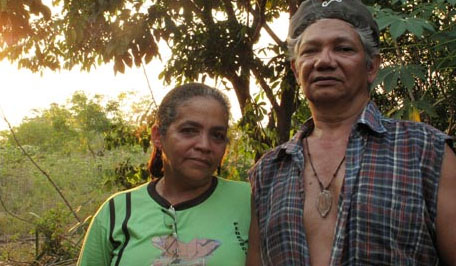
Now imagine you were doing the same thing in China, or the Congo, or Brazil, where the global environmental "Rio+20" conference is going on right now.
According to the group Global Witness, 365 environmental advocates around the world were killed for their work last year, including Jose and Maria Santos of Brazil, a married couple who were both shot down in cold blood for their work in protecting the Amazon forest from timber companies. Jose predicted his own death only six months earlier:
"I will protect the forest at all costs. That is why I could get a bullet in my head at any moment."
Brazil recorded almost half of the killings worldwide, the majority of which were connected to illegal forest clearance by loggers and farmers in the Amazon and other remote areas.
It's no picnic to be an environmental advocate in Texas, the home of the world's petrochemical industry and the country's most virulent anti-green rhetoric. But it's not a death sentence either.
ATSDR E-Mail Address For Comments is Bad, Compensates with Week Extension
 The ATSDR finally admitted that, yep, that e-mail address we published for people to submit their commnets on the Agency's Midlothian "health consultation" doesn't work and never will work, and so they're providing another and extending the commenting opportunity by one week to Friday, June 29th. Here's he entirety of the ATSDR's response:
The ATSDR finally admitted that, yep, that e-mail address we published for people to submit their commnets on the Agency's Midlothian "health consultation" doesn't work and never will work, and so they're providing another and extending the commenting opportunity by one week to Friday, June 29th. Here's he entirety of the ATSDR's response:
ATLANTA— The public comment period for the recently released Midlothian Public Health Assessment has been extended to June 29, 2012.
Comments on the document must be made in writing and those received during the public comment period will appear in the final version of the health consultation. Comments (without the names of persons who submitted them) and ATSDR’s responses to these comments will appear in an appendix to the final health consultation. Names of those who submit comments will be subject to release in answer to requests made under the U.S. Freedom of Information Act (FOIA).
Send comments to: rlm6@cdc.gov,or mail to:
ATSDR Records Center
Attn: Rolanda Morrison
Re: Midlothian Area Air Quality – PHC #1
4770 Buford Highway, NE (MS F-09)
Atlanta, Georgia 30341
No "We're sorry we screwed-up the public comment process" or "It's all our fault, try again." We could say this is one big metaphor for the Agency's multi-year invovlvement in Midlothian, but we won't. We'll let you do that in your comments.
